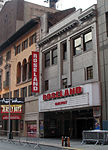Studio 54

Studio 54 is a Broadway theatre and a former disco nightclub located on 54th Street in Midtown Manhattan, New York City. The building opened in 1927 as the Gallo Opera House. It operated as an entertainment venue under various names until 1942, when CBS began using it as a radio and television studio dubbed Studio 52.In 1977, Steve Rubell and Ian Schrager opened a nightclub in the building, retaining many former TV and theatrical sets and naming it for its street. Launched at the peak of the disco dancing and music trend, the club became world-famous, noted for its celebrity guest lists, restrictive (and subjective) entry policies (based on one's appearance and style), rampant club drug use, and open sexual activity in the club's infamous balcony and basement VIP rooms. In 1980, the club shut down after its founders were convicted for evading taxes. They sold the club to Mark Fleischman, who reopened it, then sold it in 1984 to new owners, who closed it in 1986. Since November 1998, the site has served as a venue for productions of the Roundabout Theatre Company and retains the name Studio 54. A separate restaurant and nightclub, Feinstein's/54 Below, operates in the basement of the building.In 2020, it expanded into a music imprint including a record label, Studio 54 Music, and radio station on Sirius XM, Studio 54 Radio.
Excerpt from the Wikipedia article Studio 54 (License: CC BY-SA 3.0, Authors, Images).Studio 54
West 54th Street, New York Manhattan
Geographical coordinates (GPS) Address External links Nearby Places Show on map
Geographical coordinates (GPS)
| Latitude | Longitude |
|---|---|
| N 40.764361111111 ° | E -73.983777777778 ° |
Address
Studio 54
West 54th Street 254
10019 New York, Manhattan
New York, United States
Open on Google Maps







